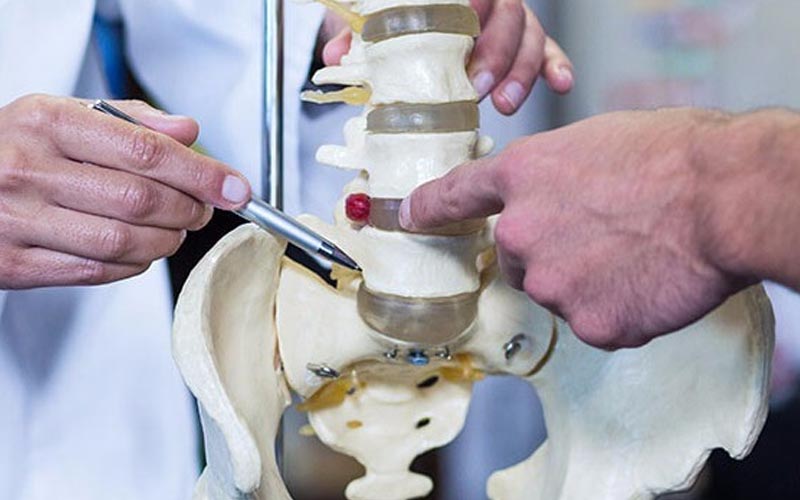Boomer Elmsdale

As we age, the cervical disks in our spine begin to collapse and bulge, which causes a loss of space between cervical vertebrae. Cervical disk degeneration happens to everyone, usually by age 60, but some experience worse degeneration than others. Scientists aren’t sure why it happens, but for those with advanced cervical disk degeneration, a total disc replacement may be needed. In some cases, disks are damaged due to injury instead of degeneration.
The cervical spine is made up of seven bones or vertebrae stacked one on top of another forming the neck. In between the vertebrae are cushions called disks. These act as shock absorbers so when they deteriorate with age, the neck can become painful and hard to move. Loss of mobility with cervical disk degeneration is common.
Because the upper part of the spinal cord passes through the cervical spine, the vertebrae or cervical disk can press on it when the opening becomes too narrow. Sometimes, the body reacts to a disrupted disk by forming bone spurs, which can also put pressure on the spinal nerves, causing pain. Pushing against the spinal nerves leads to pain, numbness and sometimes weakness in the neck and extremities. When nonsurgical treatments do not provide relief, surgery is often recommended.
Before surgery, the surgeon will provide a list of protocols to follow that support the best outcomes. Sometimes these steps are tailor made for the patient. There are, however, some common ones, including: ceasing the use of some medications and herbal supplements, stopping dangerous habits such as smoking and fasting before the procedure.
During cervical total disc replacement surgery, the degenerated disk is removed and replaced with an artificial disk. This can be done using screws or press fit. Before the surgery starts, patients are given an IV drip to relax them and will be given general anesthesia before it starts. A tube will be placed down the throat before surgery to protect the airway. A one to two inch incision is then made on the neck so the surgeon can access the affected disk. The important structures of the neck are pushed aside so the cervical disk can be reached. Then, the diseased disk is removed and the artificial disk is secured in its place either using screws of a press fit disk. After the artificial disk is placed, the incision is closed with sutures and stitches and a small dressing is placed over the wound while it heals.
After surgery, patients spend some time in recovery receiving intravenous fluids and pain medication. It is normal to experience pain after the surgery but it will subside as you heal. At home, wearing a soft or rigid neck support may be required and you’ll be on restrictive activity for about four to six weeks, although regular movement is recommended as soon as possible to prevent medical complications associated with low mobility. A few weeks after surgery, physical therapy should be started to help strengthen muscles and regain movement.
The purpose of cervical disk replacement surgery is to alleviate symptoms associated with cervical disk degeneration. Symptoms include neck stiffness, neck pain, headache, pain that travels into the shoulders and arms, weakness in hands, arms, shoulders and legs and numbness in the arms.
The surgery also works to maintain mobility, which can be lost as the cervical disks degenerate. The surgery however cannot create new mobility; it simply prevents further degeneration and loss of movement. When compared to the old method of fusing vertebrae together and removing the diseased disk, the artificial disk allows for better mobility and causes less stress on remaining vertebrae.
The biggest benefit of the cervical total disc replacement surgery over other surgical options is the ability to preserve motion. In addition, other symptoms of disk degeneration including pain, numbness and weakness in the neck and extremities can be reduced or eliminated completely.
Any surgery done on the cervical spine has risks. These include: reactions to general anesthetic, bleeding, infection, nerve injury, spinal fluid leak, a change in voice, stroke, difficulty breathing or swallowing, failure to relieve symptoms, an artificial disk that breaks or becomes loose and need for additional surgeries to replace damaged artificial disks or relieve symptoms that persist after the first surgery.
After surgery it is important to get up and move as soon as possible to avoid complications from extended bed rest including risk of deep vein thrombosis (blood clots in the deep veins) and bed sores.
After surgery, some pain is normal, but once you heal and undergo physical therapy to work on strength and mobility, reduced or eliminated symptoms are expected. Many patients also maintain mobility by going with a cervical total disc replacement as opposed to other cervical spine procedures.
Before surgical intervention, most patients will try a mix of physical therapy and pain medication to alleviate symptoms associated with degenerative disk disease. In some cases, steroid injections will be given in the spine. In addition to cervical total disc replacement surgery, other surgical methods are available. Before the use of artificial disks were widely available, most patients had the degenerated disk removed and vertebrae were fused together. Surgical options include posterior discectomy, lamino-foraminotomy and anterior cervical discectomy and fusion surgery, the last of which is similar to a total disc replacement but without the use of an artificial disk replacement.
The average cost of cervical disc replacement surgery is about $12,000 to $40,000, with the cost of the artificial disc running about $4,500. Insurance will likely cover some or all of the procedure, so check with your provider for an accurate estimate of out of pocket costs. Where you get the procedure done and who performs it will also affect cost. Don’t forget to factor in aftercare, including physical therapy.
“Cervical Spine Surgery 101.” Johns Hopkins Medicine Health Library. Accessed May 01, 2018. https://www.hopkinsmedicine.org/healthlibrary/test_procedures/neurological/cervical_disk_replacement_surgery_135,6.
“Treatments.” Cervical Disc Replacement. Accessed May 01, 2018. https://www.spine.org/KnowYourBack/Treatments/SurgicalOptions/CervicalDiscReplacement.
Q&A: Artificial Cervical Discs W/ Dr. William Tobler. Accessed May 01, 2018. https://www.mayfieldclinic.com/QA_ArtificialCervicalDisc.htm.